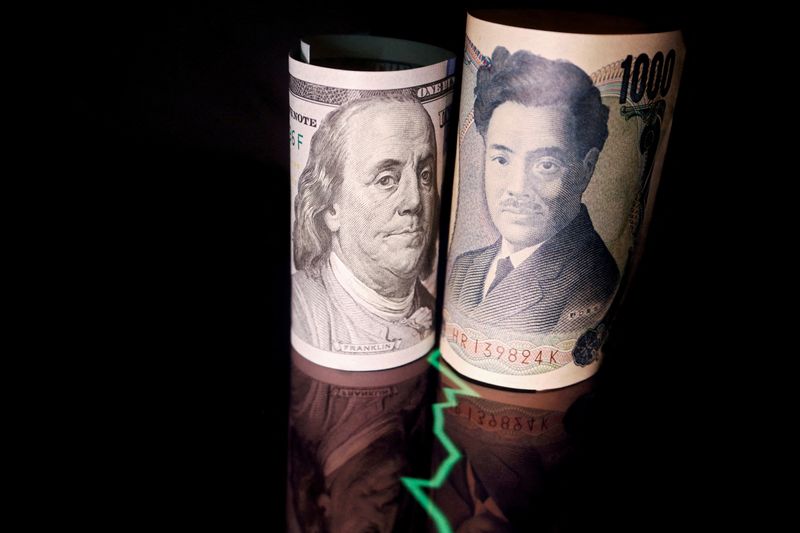By Tetsushi Kajimoto and Leika Kihara
TOKYO (Reuters) - The yen surged against the dollar on what traders suspect was another round of intervention by Japanese authorities to stem the currency's sharp declines.
While authorities have not confirmed whether they stepped in, below are some hints on Tokyo's new intervention tactics:
WHY DID THEY STEP IN?
The yen fell below the key 160-to-the-dollar line after Bank of Japan Governor Kazuo Ueda said on Friday the currency's recent declines had little immediate impact on prices - remarks traders saw as ruling out a near-term interest rate hike.
Having seen the dollar/yen spike above the psychologically important 160 mark, Japan likely intervened on Monday to arrest what top currency diplomat Masato Kanda described as "excessive volatility driven by speculative trading."
Kanda, who oversees Japan's currency policy, declined to comment on whether authorities stepped in but said they "hope to continue taking appropriate action as needed."
Tokyo is suspected to have intervened again in early Asian hours on Thursday, likely to arrest abrupt yen moves after U.S. Federal Reserve Chair Jay Powell's news conference.
Japanese policymakers have said the weak yen hurts the economy by boosting import costs, suggesting they could intervene not only to stem sharp moves but to keep excessive yen rises from hitting households via rising living costs.
WHAT'S DIFFERENT THIS TIME?
Traders suspect authorities stepped in at least on two days this week, both at unusual timings. The first time was on Monday, when Japanese markets were closed for a holiday. The second was shortly after the U.S. stock market closed in early Asian hours on Thursday.
This shows Japanese authorities would step in any time of the day, regardless of whether Tokyo markets are open, if they see the need to prevent sharp moves in the yen.
In the past, they would typically prefer to step in during Tokyo market hours when they could place orders with trusted dealers at Japanese megabanks.
WHAT IS AUTHORITIES' NEW LINE-IN-THE-SAND?
Authorities look more at the speed, rather than the level, of the yen in deciding when to intervene. But market players and former finance ministry officials see 160 yen to the dollar as authorities' line-in-the-sand for intervention.
Daisaku Ueno, chief FX strategist at Mitsubishi UFJ (NYSE:MUFG) Morgan Stanley Securities, says authorities likely bought yen around 157-159 to the dollar in several stages this week, to create a buffer to defend the 160 mark. The dollar last stood at 155.70 yen in Asia on Thursday.
Ueno, who is well-versed in yen flows, also said the dollar's next resistance stood at 164.50 yen hit in 1985. Once that is breached, there is no technical resistance until 260, he says.
DID JAPAN GET G7 CONSENT?
The decisive moment was on April 17, when Japan and South Korea succeeded in getting U.S. to acknowledge their "serious concerns" about their currencies' declines in a trilateral finance leaders' gathering.
During their stay in Washington on the sidelines of the IMF meetings in April, Japanese officials also lobbied to get G7 consent on dealing with excessive currency volatility as needed.
U.S. Treasury Secretary Janet Yellen told Reuters on April 25 that the robust dollar reflected the strength of the U.S. economy, insisting that interventions by governments in currency markets were acceptable only in rare circumstances.
The remarks suggest Washington won't join Tokyo in coordinated intervention, but won't openly criticise its intervention either as long as they are targeted and focused on arresting speculative, sharp falls in the yen.
HOW MANY TIMES MORE CAN JAPAN INTERVENE?
When Tokyo intervenes to support the yen, authorities tap Japan's $1.29-trillion worth of foreign reserves for dollars to sell for yen.
Of the total, roughly $155 billion is held in deposits and another $994 billion in securities of which most are seen as U.S. Treasuries. Combined, Japan theoretically has $1.15 trillion it can tap swiftly for intervention.
But analysts are divided on how much can actually be used for intervention as some securities may not be easy to sell. Some put the limit at around $300 billion, while others see scope for authorities to spend much more.
Tokyo is estimated to have spent roughly 5.5 trillion yen ($35 billion) in Monday's intervention. Authorities could intervene about eight times on the same scale based on the limit of around $300 billion, or several more times depending on how willing they are to unload their U.S. Treasuries.
($1 = 155.7900 yen)
